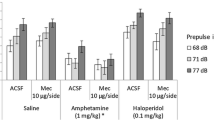Abstract
Forty-eight male Wistar rats were exposed to contingent light-shock combinations and 48 rats received light and shock stimuli in a random order. One day after fear conditioning the animals were tested for startle potentation after injection of midazolam (0, 0.5, 1.0, 2.0 mg/kg, IP) or DMCM (methyl-6,7-dimethoxy-4-ethyl-beta-carboline-3-carboxylate; 0, 0.1, 0.2, 0.4 mg/kg IP) or lindane (0, 7.5, 15.0, 30.0 mg/kg PO). Midazolam attenuated potentiated startle dose dependently and the inverse benzodiazepine agonist DMCM had the opposite effect. The effects of lindane on startle amplitudes were identical to those of DMCM, indicating that lindane has anxiogenic effects on behavior. It is suggested that the anxiogenic effects of lindane are mediated by an effect at the GABA-ionophore complex.
Similar content being viewed by others
References
Abalis IM, Eldefrawi ME, Eldefrawi AT (1985) High-affinity stereospecific binding of cyclodiene insecticides and gamma-hexachlorocyclohexane to gamma-aminobutyric acid receptors of rat brain. Pestic Biochem Physiol 24:95–102
Abalis IM, Eldefrawi ME, Eldefrawi AT (1986) Effects of insecticides on GABA-induced chloride influx into rat brain microsacs. J Toxicol Environ Health 18:13–23
Bloomquist JR, Soderlund DM (1985) Neurotoxic insecticides inhibit GABA-dependent chloride uptake by mouse brain vesicles. Biochem Biophys Res Commun 133:37–43
Cooper SJ (1987) Bidirectional changes in the consumption of food produced by beta-carbolines. Brain Res Bull 19:347–358
Corda MG, Blaker WD, Mendelson WB, Guidotti A, Costa E (1983) Beta-carbolines enhance shock-induced suppression of drinking in rats. Proc Natl Acad Sci USA 80:2072–2076
Davis M (1979) Diazepam and flurazepam: effects on conditioned fear as measured with the potentiated startle paradigm. Psychopharmacology 62:1–7
Davis M (1986) Pharmacological and anatomical analysis of fear conditioning using the fear-potentiated startle paradigm. Behav Neurosci 100:814–824
Davis M, Redmond DE, Jr, Baraban JM (1979) Noradrenergic agonists and antagonists: effects of conditioned fear as measured by the potentiated startle paradigm. Psychopharmacology 65:111–118
File SE, Baldwin HA (1987) Effects of beta-carbolines in animal models of anxiety. Brain Res Bull 19:293–299
Hitchcock JM, Davis M (1986) Lesions of the amygdala, but not of the cerebellum or red nucleus, block conditioned fear as measured with the potentiated startle paradigm. Behav Neurosci 100:11–22
Hoffman HS, Ison JR (1980) Reflex modification in the domain of startle: I. Some empirical findings and their implications for how the nervous system processes sensory input. Psychol Rev 87:175–189
Joy RM, Albertson TE (1985) Lindane and limbic system excitability. Neurotoxicology 6:193–214
Joy RM, Albertson TE (1987a) Factors responsible for increased excitability of dentate gyrus granule cells during exposure to lindane. Neurotoxicology 8:517–527
Joy RM, Albertson TE (1987b) Interactions of lindane with synaptically mediated inhibition and facilitation in the dentate gyrus. Neurotoxicology 8:529–542
Kehr W, Stephens DN (1984) Further evidence that central benzodiazepine receptor ligands may exhibit anxiogenic properties. Br J Pharmacol 81:42P
Lawrence LJ, Casida JE (1984) Interactions of lindane, toxaphene and cyclodienes with brain-specific t-butylbicyclophosphorothionate receptor. Life Sci 35:171–178
Matsumura F (1985) Involvement of the picrotoxinin receptor in the action of cyclodiene insecticides. Neurotoxicology 6:139–164
Matsumura F, Tanaka K (1984) Molecular basis of neuroexcitatory action of cyclodiene-type insecticides. In: Narahashi T (ed) Cellular and molecular neurotoxicology. Raven Press, New York, pp 225–240
Mondlock JM, Davis M (1985) The role of various amygdala projection areas (bed nucleus of stria terminalis, rostral lateral hypothalamus, substantia nigra) in fear-enhanced acoustic startle. Neurosci Abstr 15:331
Obata T, Yamamura HI (1986) The effect of benzodiazepines and beta-carbolines on GABA-stimulated chloride influx by membrane vesicles from the rat cerebral cortex. Biochem Biophys Res Commun 141:1–6
Pellow S, File SE (1984) Multiple sites of action for anxiogenic drugs: behavioural, electrophysiological and biochemical correlations. Psychopharmacology 83:304–315
Petersen EN, Jensen LH, Honore T, Braestrup C (1983) Differential pharmacological effects of benzodiazepine receptor inverse agonists. In: Biggio G, Costa E (eds) Benzodiazepine recognition site ligands: biochemistry and pharmacology. Raven Press, New York, pp 57–64
Stephens DN, Schneider HH, Kehr W, Jensen LH, Petersen E, Honore T (1987) Modulation of anxiety by beta-carbolines and other benzodiazepine receptor ligands: relationship of pharmacological to biochemical measures of efficacy. Brain Res Bull 19:309–318
Taylor SC, Little HJ, Nutt DJ, Sellars N (1985) A benzodiazepine agonist and contragonist have hypothermic effects in rodents. Neuropharmacology 24:69–73
Thiebot MH, Soubrie P, Sanger D (1988) Anxiogenic properties of beta-CCE and FG 7142: a review of promises and pitfalls. Psychopharmacology 94:452–463
Tischler MD, Davis M (1983) A visual pathway that mediates fear-conditioned enhancement of acoustic startle. Brain Res 276:55–71
Tusell JM, Sunol C, Gelpi E, Rodriguez-Farre E (1987) Relationship between lindane concentration in blood and brain and convulsant response in rats after oral or intraperitoneal administration. Arch Toxicol 60:432–437
Woolley D, Zimmer L, Dodge D, Swanson K (1985) Effects of lindane-type insecticides in mammals: unsolved problems. Neurotoxicology 6:165–192
Author information
Authors and Affiliations
Rights and permissions
About this article
Cite this article
Hijzen, T.H., Slangen, J.L. Effects of midazolam, DMCM and lindane on potentiated startle in the rat. Psychopharmacology 99, 362–365 (1989). https://doi.org/10.1007/BF00445558
Received:
Accepted:
Issue Date:
DOI: https://doi.org/10.1007/BF00445558




